
FLORA
-Mysteries,THE PAINTINGS OF SUSAN SEDDON BOULET, June 8-14, 1997
Catalog No. 98154. Published by Pomegranate Calendars & Books, California, 1997
Susan Seddon Boulet Quotations compiled by Michael Babcock

FLORA
-Mysteries,THE PAINTINGS OF SUSAN SEDDON BOULET, June 8-14, 1997
Catalog No. 98154. Published by Pomegranate Calendars & Books, California, 1997
Susan Seddon Boulet Quotations compiled by Michael Babcock
|
Flora, "flourishing one," was the Roman goddess of flowers, gardens, and spring. She is the embodiment of all nature; her name has come to represent all plant life. She is especially a goddess of Powers, including the flower of youth. Her festival of unrestrained pleasure, the Floralia, was celebrated at the end of April and beginning of May, this festival was probably the origin of the maypole dance and the gathering of bouquets of flowers, symbolizing the bringing of spring and new life into the world. She gives charm to youth, aroma to wine, sweetness to honey, and fragrance to blossoms. Flora teaches us to honor growing things, both inside and outside us. She is a reminder to pay attention to pleasure, to the beauty of spring, and to new life, wherever it is found.
Guirand, Felix, ed. THE LAROUSSE ENCYCLOPEDIA OF MYTHOLOGY. Trans. Richard Aldrington and Delano Ames, New York. Barnes & Noble Books. 1994, 210 Flora. In primitive central Italy Flora was the goddess of budding springtime, of cereals, fruit trees, the vine and flowers. With Robigus (or Robigo) she prevented wheat-rust. With Pomona she watched over fruit trees. She had a temple on the Quirinal and another near the Circus Maximus. Her festivals, the Floralia, lasted from the twenty-eighth of April to the third of May and were rather licentious. On the twenty-third of May there was another festival in her honour, a rose festival. The Sabines and the Latins venerated another goddess, Feronia, who shared some of Flora's functions and watched over spring flowers and vegetation. It is possible that Feronia was originally an underworld divinity. She was associated with Soranus, a Sabine divinity who became a solar god after first having been a god of the underworld. In the course of a sacrifice which mountaineers were offering on Mount Soracte wolves appeared and seized the offerings; they then took refuge in a cave from which escaped pestilential vapours. The oracle declared that these wolves were under the protection of the god Soranus and instructed the mountaineers to live by rapine, like the wolves. Whence arose the name Hirpi Sorani which was given to them. The name was perpetuated in a Roman family, especially devoted to the cult of Soranus and Feronia. During the festivals of Feronia members of this family, the Hirpirri, would walk bare-footed over glowing coals without burning themselves. |

The Farnese Flora. The goddess of spring and flowering or blossoming plants, Flora was an Italian goddess
whose cult was in existence at Rome at an early date. A temple was dedicated to her in 238 B.C. on the
advice of the Sibylline Books and her festivals, the Floralia, were celebrated annually. She was later
identified with the Greek goddess Chloris. May-blossom was associated with her worship
 |
 |
 |
 |
 |